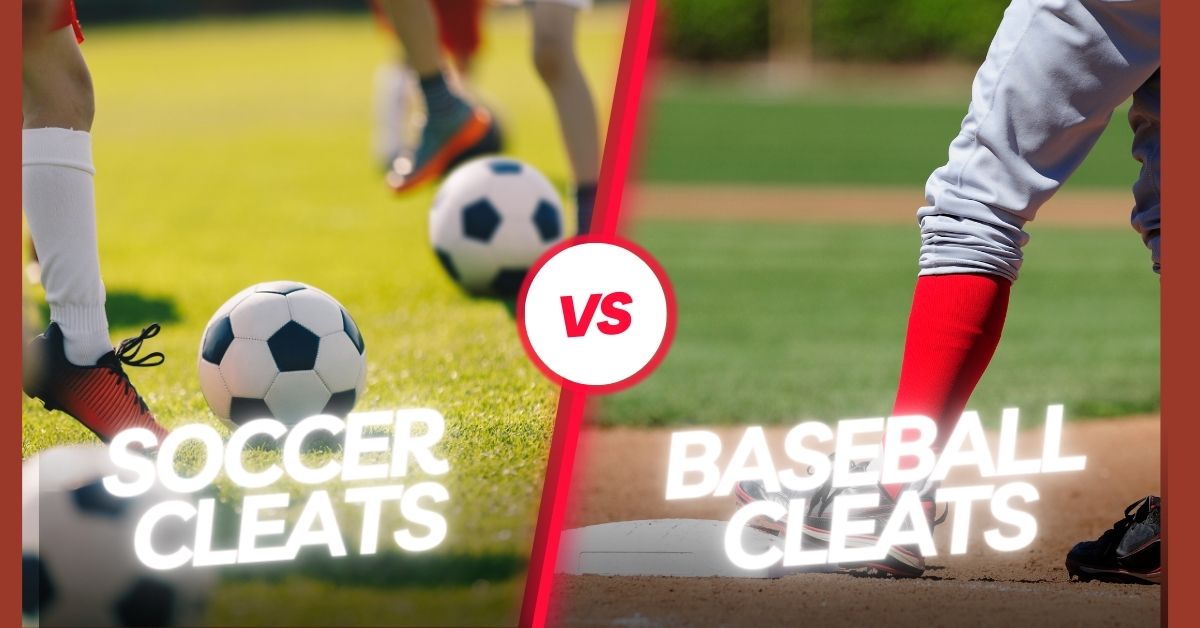Sports gear is all about specificity.
One size never fits all, which is extremely evident when you compare soccer cleats and baseball cleats.
Though they are designed for their respective sports, they do share one thing in common: the ability to help players perform and stay safe. But can you wear one for the other?
The simple answer is NO. These two types of cleats are built differently, so visually, they may look similar, but how they’re structured and designed is tailored to each sport’s demands.
Let’s dive in more.
Why Are Baseball Cleats and Soccer Cleats Different?
Toe Cleat: Baseball cleats have an extra cleat at the toe, which helps with quick starts and stops, a common movement in baseball.
This toe cleat is absent in soccer cleats as it can potentially cause injury in high-kicking movements characteristic of soccer.
Weight and Cut: Soccer cleats are typically lighter and have a low-cut style to allow for maximum agility and quick footwork, which is crucial for soccer players.
On the contrary, baseball cleats, while also lightweight, may be slightly heavier and feature a higher cut to provide ankle support when running the bases.
Traction and Durability: The design and structure of baseball cleats are intended to provide excellent traction on hard clay or grass baseball fields, thus enhancing durability.
Soccer cleats, though also designed for outdoor play, may wear out faster when used on a baseball field due to the hard clay or grass surface.
Sport-Specific Design: Each cleat is specifically designed keeping in mind the unique demands of their respective sports.
This ensures optimized performance and safety of the players.
Can You Wear Baseball Cleats for Soccer?
Using baseball cleats for sports other than baseball is generally not recommended.
Baseball cleats are designed specifically for baseball, with features like a toe cleat that could potentially cause injury in sports like soccer that involve high-kicking movements.
However, there are some exceptions to consider.
For example, if you’re playing in a casual or non-competitive setting, using baseball cleats might be okay.
Additionally, there are some cleats that are designed to be versatile and can provide the necessary traction and support for multiple sports.
Nevertheless, for safety and optimal performance, it’s always best to wear the appropriate footwear for each specific sport.
Soccer Cleats vs. baseball Cleats
Soccer Cleats
Soccer teams are made up of 11 players who are always running on the field. As a result, the cleats are not usually heavy.
Soccer cleats are lightweight. They are made out of rubber or plastics. These cleats are really thin to balance on the ground for running.
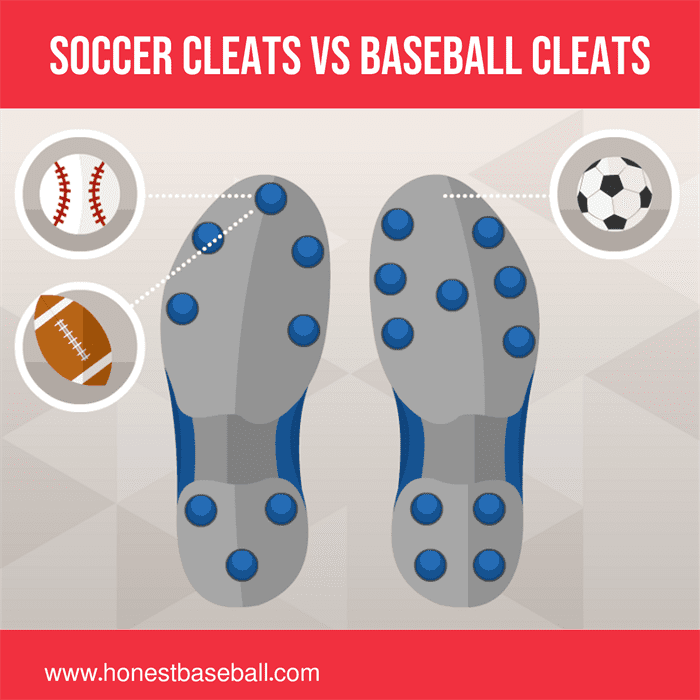
The cleat pattern must not harm the balance while running. All the players, especially youth soccer leagues, require good quality cleats. But these cleats do have ankle support features.
The cleats’ main target is to give a nice running feel while on the field, protect the players, give ankle support, and tightly embrace the shoe so that playing soccer becomes easier.
Soccer tackles require far more strength than baseball on the field. So, soccer players are more physically comfortable running on the field rather than stable, standing firm on the ground, and running while the time comes.
Baseball Cleats
Baseball shoes are fundamentally different from a pair of soccer shoes.
Baseball shoes tend to provide more stability and have different types of cleats than soccer.
While soccer needs constant movement, baseball is a different type of sport that needs stability and comparability for the base runners as well as fielders to move every now and then.
Stability and movement are both important when it comes to baseball.
The biggest difference may be the cleats themselves. These cleats are usually made out of metals, and the foot movement can be easily controlled.
With the pointy cleats, you can control the nature of the movement in the baseball game.
While soccer cleats can let a player be in constant movement, baseball cleats make sure the player can firmly stand as well as move freely.
That’s why the weight difference and eyelet positioning differ.
Differences In Baseball And Soccer Cleats
Let’s not make any further discussion rather let’s look at the different points while it comes to soccer cleats vs baseball cleats in detail-
Direct Comparison Between The Two Types Of Cleats
Following is a table on the direct comparison between the two types of cleats.
| Particulars | Soccer Cleat | Baseball Cleat |
| Extra Toe Stud In The Baseball Shoe | No | Yes |
| Material | Rubber, Plastic | Molded Plastic, Metal |
| Weight Of The Spike | Lighter | Heavier |
| Ankle Support | No | Yes |
| Tongue | Minimal | Cushioned |
| Heel | Heel Cap | Cushioned |
Extra Toe Stud In The Baseball Shoe
This is one of the most important differences between baseball sports shoes and soccer shoes.
A pair of baseball cleats has extra toe studs. It is usually made out of metal. You use it to guard the toe as well as to stand firm on the ground.
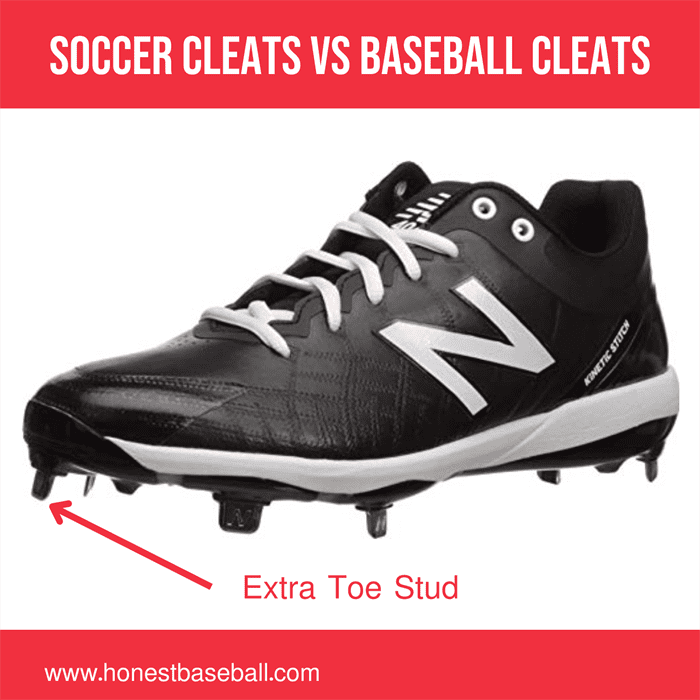
Standing on the ground in a baseball game is important, besides running on the field. Extra toe stud gives the support to become grounded on the field.
But you cannot find this extra toe stud on the soccer cleats. Soccer cleats are rather balanced cleats. These have spikes in the midsole.
Rubber toe guards or metal toe studs are both important on the baseball field. This fundamental difference makes baseball shoes different from soccer.
Soccer players wear shoes with toe boxes that let them move freely on the whole field.
On the other hand, the movement of a baseball player is limited.
New, younger players often lose direction while running on a diamond field.
To prevent injuries, their movement should be controlled, not like soccer, where you can move freely in a strike zone.
That is why toe stud is so important when it comes to the differences among the two types of cleats.
Material
Material makes a huge difference when it comes to soccer cleats vs baseball cleats.
Soccer cleats are usually made out of rubber or plastic, lighter materials, while baseball cleats are made out of mostly metal or rubber. Rarely plastic.
Cleats can provide balance and stability on the ground more than any other sportswear.
Soccer cleats require such freedom that you can keep constant movement on the field. The toe guard or the front toe stud is less required by them.
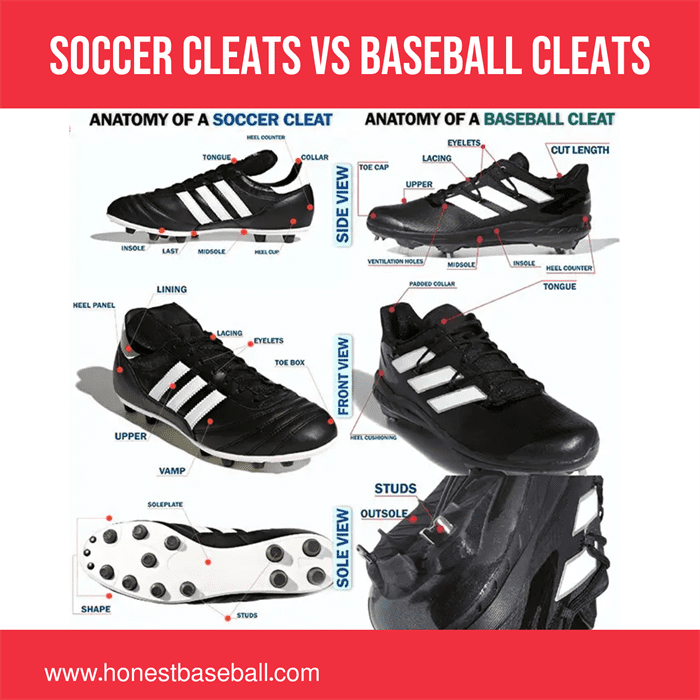
The spikes are light so that you move freely. A midfielder can change into a striker without delay. The field is not the same everywhere.
On the other hand, a pitcher needs cleats to throw the ball firmly, while a batter needs to stand up in a position to defend. The fielders need running ability in the field.
All the players have different reasons for standing as well as movement. High-top cleats for baseball games always use genuine leather or synthetic leather, as well as molded plastic cleats, while high-top cleats for soccer games use synthetic leather or plastic.
That is why the cleats must be heavier and more stable. But at the same time, it is so lightweight that the players can move freely on the ground. It is also a matter of debate if molded plastic cleats are better than metal cleats, and you should be aware of that.
Weight Of The Spike
Lightweight – is the first rule of soccer cleats. That is why soccer shoes have spikes made out of rubber and plastic.
Baseball cleats are pointy. They are also stronger. On the other hand, soccer cleats are rounded.
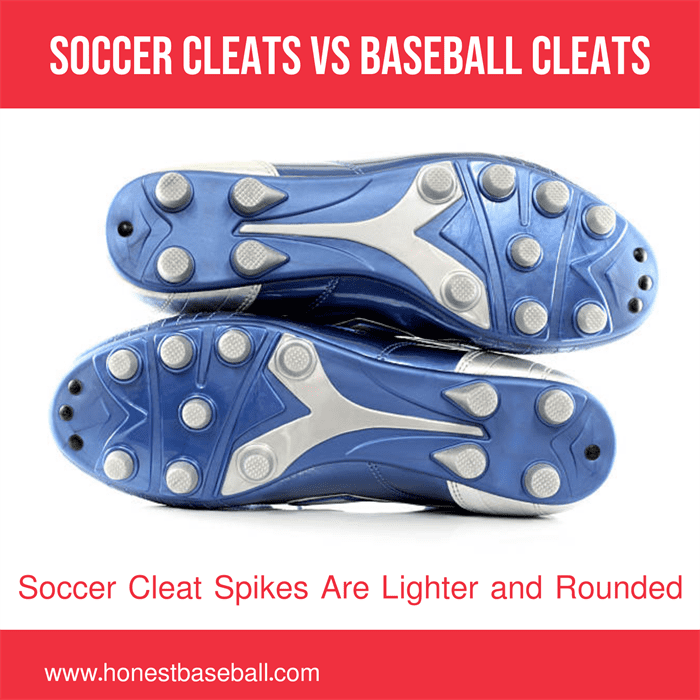
Soccer spikes are light and rounded. As a result, movement is fast. Material and design dedicated to the spikes of the soccer cleats turn them lighter than those of baseball cleats.
Soccer fields are full of grasses, and even when rain happens, the spikes are lightweight enough to support full-field running.
On the other hand, baseball cleats are made out of metal with designs to grab the soil under the foot. That gives the shoes enough power to give the player full stability.
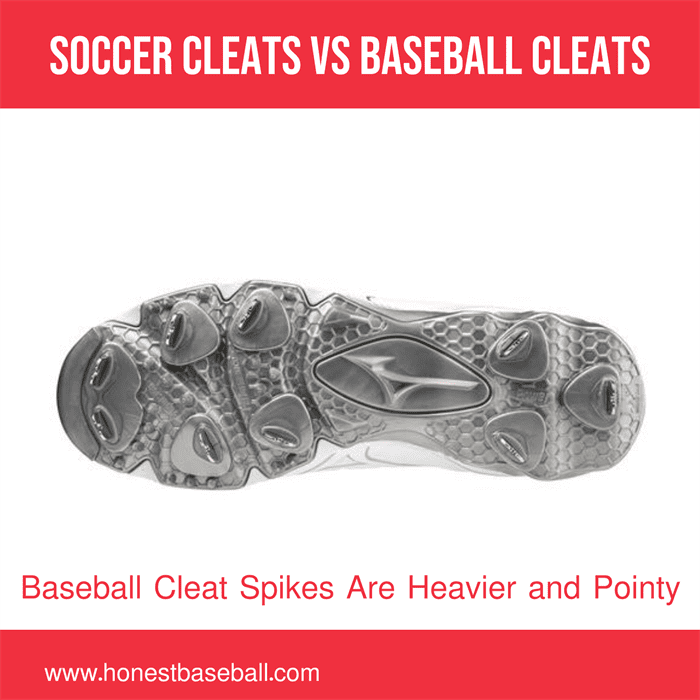
One pair of metal cleats is always heavier than one pair of soccer cleats. Soccer cleats made out of plastic cleats are always lighter. Even turf cleats for baseball or softball are heavier than them.
That is why baseball cleats for soccer do not match, as they try to make the players stable on the field rather than giving excessive mobility that they deserve.
On the other hand, soccer cleats for baseball also do not match as they do not give enough stability on the ground.
As soccer players often clash physically while playing, the spikes, if they become heavier, will hurt a serious player. On the other hand, such clashes happen almost never on the diamond field.
Ankle Design To Wear Soccer Cleats Differ With Baseball Cleats
Soccer cleats for baseball are not often used, clearly because of the lack in ankle support. The ankle support is available on baseball cleats.
Baseball players run in far different motions than soccer players. Rules are fundamentally different in the two games.
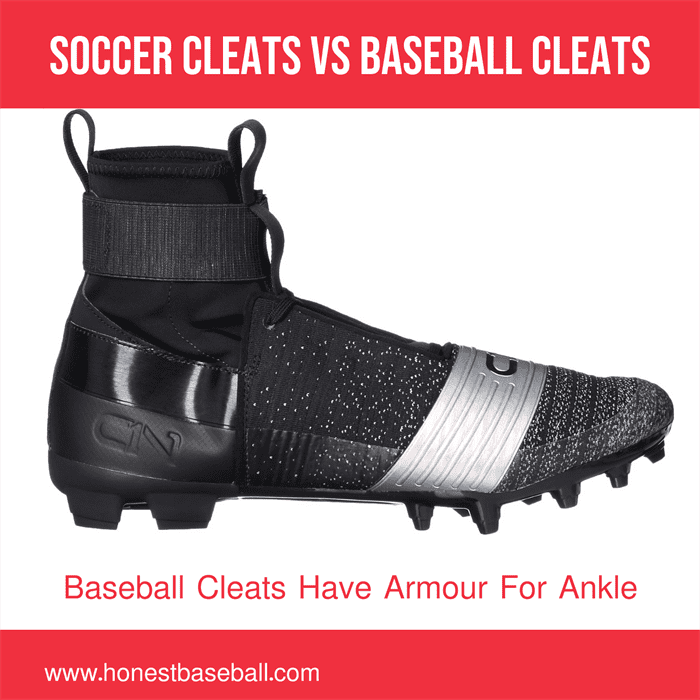
Baseball players face different problems on the field than soccer players. When I started playing baseball, I was a soccer player, too. I saw that soccer and baseball running movements are totally different.
While you can run freely on soccer grounds, as a batter or a fielder, you do not have that independence on a baseball field. Ankle support is necessary all the time.
Especially for the batter while running on the base and for the fielders who tend to bow most of the time to catch the ball, ankle support and toe cleats give real fun to play baseball.
So, for safety reasons, ankle support in soccer cleats and baseball cleats is really important. They are often made out of synthetic leather or genuine leather. Plastic cleats for soccer designs mostly do not carry ankle support.
So, if you want ankle support on two cleats, then you should wear proper baseball cleats rather than soccer cleats for baseball on the baseball field.
Tongue Of Baseball And Soccer Cleats
Baseball games involve baseball players who need to be grounded on the field. Their cleats have cushioned midsoles for comfort.
On the other hand, soccer cleats, especially those plastic cleats, do not have padded tongues.
The tongue, if it becomes padded, makes the cleats fit for being grounded as well as running.
If the middle sole is designed to be minimal, then you can run freely with the cleats.
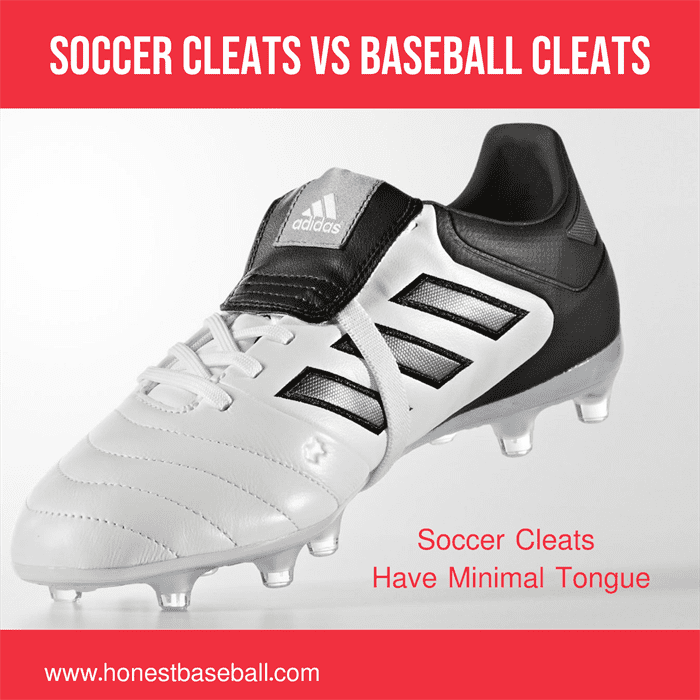
That is why baseball cleats for soccer are a no-no often on the field. Because baseball cleats for soccer games would make the players more grounded than usual.
If you have played baseball with soccer cleats, then you have already felt that it is lighter on the ground and really tough to ground yourself if you are a batter.
That’s why soccer cleats for baseball are often avoided by batters.
Soccer and baseball cleats are designed to be fundamentally different. Because of this, they can even cause problems on the field.
Heel
The heels in the baseball cleats have cushioning as they need more cushioning for a firm grounding. Without a cushioned heel, it is tough to wear baseball cleats for a long time.
It also helps the player to guard the heel against unwanted problems.
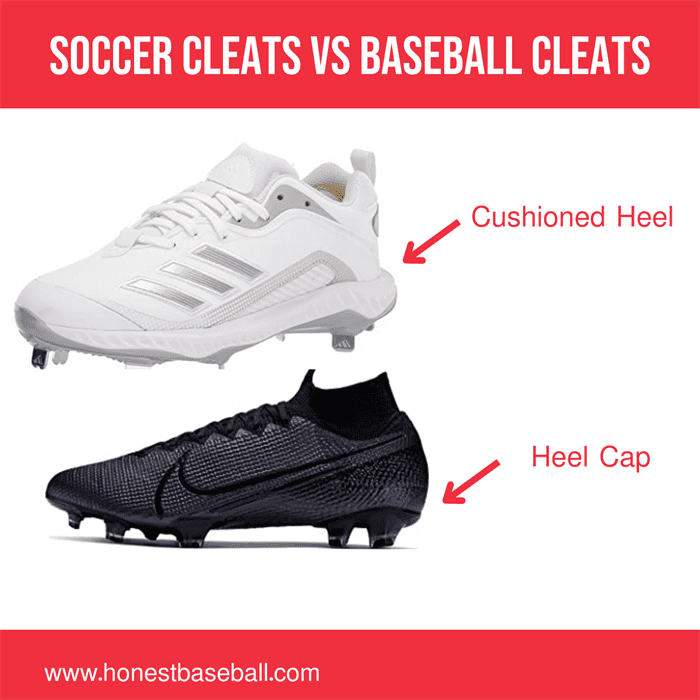
On the other hand, if you are using soccer cleats, you will find that the heel has a cup but is not cushioned like baseball cleats.
It gives them the opportunity to run freely on the ground.
My Verdict
My direct opinion is that you can use soccer cleats for baseball practice but not for a baseball game.
On the other hand, it is really tough to use baseball cleats on the soccer field due to the difference in design, material, and functions.
You should be extra careful when it comes to children and younger players.
More Resources
Can You Use Baseball Cleats for Football?
Can You Use Metal Cleats In High School Baseball

Hello everyone. My name is Jason Butler, and I live in California, America. I was a professional AAA Minor League Baseball player. I lost my chance of playing MLB for injury issues, but I did not lose my love for baseball. I attended the coaching training program and am now working as a coach in a small school in San Diego.
I always love to share my experience and knowledge if that can help you. Play baseball, and stay fit.
